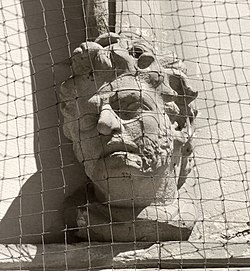Charles Mawer | |
|---|---|
 Portrait of Charles Mawer aged about 29 years, on Old Commercial Bank, Bradford | |
| Born | circa 1839 |
| Died | 8 December 1903 Union Workhouse, Skipton |
| Nationality | British |
| Notable work | Restoration of: St Michael, Barton-le-Street, 1871 Architectural sculpture on: Kirkgate Market Bradford, 1872 St Matthew, Lightcliffe, 1875 St Thomas, Killinghall, 1880 |
| Style | Gothic Revival |
| Movement | Aesthetic movement Romanticism Gothic Revival |
Charles Mawer (1839–1903) (fl. 1860–1881) was an architectural sculptor, based in Leeds, West Yorkshire, England. He was the son of sculptors Robert and Catherine Mawer and the cousin of William Ingle. He was apprenticed to his father, and worked within the partnership Mawer and Ingle alongside his cousin William and his own mother between 1860 and 1871, and then ran the stone yard himself until he formed a partnership with his fellow-apprentice Benjamin Payler in 1881. Following that date, his whereabouts and death are unknown. His last major work for Mawer and Ingle was Trent Bridge, where he carved alone, following the death of William Ingle. He is noted for his work on the rebuilding of the mediaeval Church of St Michael and All Angels, Barton-le-Street, completed in 1871, where he repaired and recreated damaged and missing Romanesque carvings, and for his carving on William Swinden Barber's 1875 Church of St Matthew, Lightcliffe. Charles' last known work ornaments another Barber church: the 1880 Church of St Thomas the Apostle, Killinghall. Charles was a member of the Mawer Group of Leeds architectural sculptors, which included those mentioned above, plus Matthew Taylor.